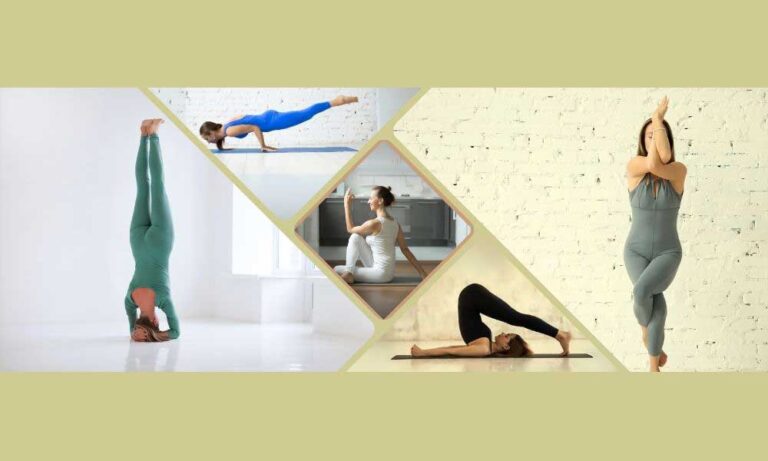Yoga Practice Name
Hamsasana (हंसासन)


Hamsasana (हंसासन)
Swan Pose or Balance Pose on Hands
Hamsasana is a traditional arm-balancing posture in Hatha Yoga. The body is held parallel to the ground, supported on the palms and toes, with the elbows pressing gently into the abdomen. It builds upper body strength, stimulates the digestive organs, and develops balance and focus. The posture symbolizes the grace and poise of a swan.
1. Starting Position – Vajrasana (Thunderbolt Pose):
Sit on your heels with your spine upright and hands resting on the thighs.
2. Place the Palms on the Floor: Lean forward slightly and place both palms flat on the floor, fingers pointing forward, shoulder-width apart.
3. Bend Elbows and Tuck Them into the Abdomen: Bring your elbows in and gently press them into the abdominal region, ideally around the navel area or slightly below.
4. Stretch the Legs Backward: Extend both legs straight back, tucking the toes under. Keep the body straight and horizontal, balancing on your palms and toes.
5. Lift the Torso Off the Floor: Shift your body weight forward, gradually lifting the chest and legs so the entire body is parallel to the floor. Engage your core and arm muscles.
6. Hold the Pose: Maintain the posture while breathing slowly and steadily. Hold for 15–30 seconds (or longer with practice).
7. To Release: Gently lower your body, bring the knees back to the ground, and return to Vajrasana to rest.
1. Requires Arm and Core Strength – Beginners or those with weak upper body muscles may find it difficult to balance. It's recommended to build strength gradually.
2. Maintain Proper Alignment – Incorrect technique or overexertion may cause wrist strain, shoulder tension, or elbow injury. Always warm up beforehand.
3. Avoid Jerky Movements – Moving too quickly into the pose may cause imbalance or falling forward. Enter and exit the pose slowly and mindfully.
1. Hernia or Abdominal Surgery – The elbow pressure on the abdomen can worsen hernia or disturb healing after abdominal operations.
2. Pregnancy – This pose involves abdominal compression, which makes it unsafe during any stage of pregnancy.
3. Carpal Tunnel Syndrome or Wrist Injuries – Individuals with wrist issues should avoid pressure on the palms or use wrist support under expert guidance.
4. High Blood Pressure or Heart Conditions – Due to the physical exertion and balancing effort, it should be practiced with medical clearance in such cases.
5. Peptic Ulcer, Hyperacidity, or Severe Digestive Disorders – The elbow pressure may aggravate ulcers or acidity and should be avoided unless advised by a qualified yoga therapist.
5. Balasana (बालासन) – Child’s Pose: Acts as a restorative counterpose to release pressure from the abdomen and arms, providing grounding and relaxation.
Mayurasana, Chaturanga Dandasana, Plank Pose (Phalakasana), Bakasana, Kukkutasana
1. Requires Foundational Upper Body Strength – Hamsasana is an intermediate arm-balancing posture that engages the wrists, arms, shoulders, and core. A good warm-up and prior strength-building (e.g., Plank, Chaturanga) are beneficial.
2. Emphasis on Abdominal Compression – The elbows press firmly into the abdomen, stimulating the digestive fire (Agni). This makes it a highly detoxifying pose but requires care and control.
3. Balance with Stability and Breath Control – Success in Hamsasana lies in calm, focused breathing, a tight core, and steady gaze. Sudden shifts in focus or breath can disturb balance.
4. Alignment Is Crucial – The palms should be firmly grounded, fingers spread, and elbows should not splay out. Keep the body parallel to the floor, avoiding sagging or lifting the hips too high.
5. Best Practiced on Empty Stomach – Since the pose involves strong abdominal engagement, it's best done early in the morning or at least 3–4 hours after a meal.
6. Advance Only with Control – Beginners should build strength with preparatory poses like Plank, Bakasana, and Mayurasana. Do not rush into full balance without mastering the setup.
7. Mind-Body Coordination Tool – The challenge of balancing on the hands enhances mental focus, self-discipline, and inner awareness, making it as much a meditative practice as a physical one.
GS: 2.34-35 / HYP: 1.30-31 / SS: 3.35